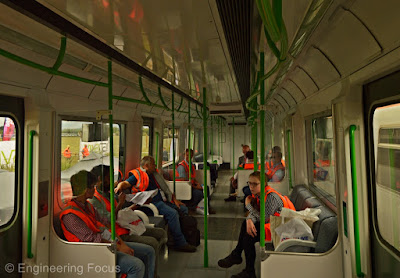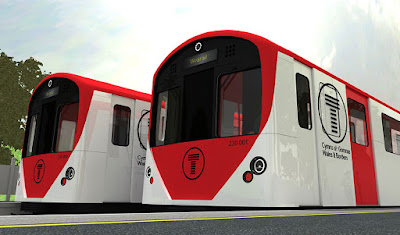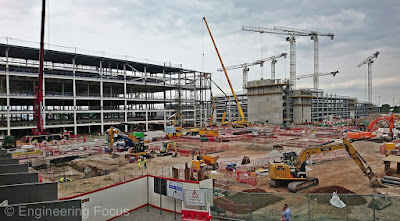Even with the development of newer more efficient petrol engines, they are unable to compete with diesel engines for fuel efficiency, pure pulling power and reliability. That is why diesel engines still power the modern economy, diesel engines are used to power the machinery which produces the food we eat and drive the vehicles which transports the goods we buy.
So, it was with great surprise and disappointment that I learned (admittedly this was some years ago) that some car manufacturers were cheating the system and were allegedly building diesel powered vehicles that emitted more dangerous gasses than were allowed under US and EU law. This news has since gone on to have a huge knock-on effect to vehicle manufacturers, even those for which no allegations were leveled against them.
I believe however that news reports on the story at the time were confusing and didn't really explain what particular legislation the engines were falling foul of, nor in my opinion did the media fully explain which emissions were being released at levels above those allowed.
To be Frank I think the media and government's subsequent over-reaction lead to the collapse of the market in diesel engines, a fact which has has been particularly harmful to the UK vehicle manufacturing industry.
Jaguar Land Rover in particular has paid a heavy price for the fallout from diesel-gate, being that diesel powered vehicles make up a large proportion of those sold by the company. Diesel engines after all being most suited to large vehicles such as Land-Rover 4x4s and sports utility vehicles.
Environmentalists will probably be chomping at the bit to explain why it was the vehicle manufacturers fault that diesel-gate happened at all, but let me explain why I think the Governments' move to being anti-diesel was and is an overreaction.
I should start by saying that I am in no way defending those manufacturers who cheated the system, what they did was outrageous and unacceptable but I do think that the media and government has a lot to answer for in its response.
If I'm perfectly honest I don't know full details of how manufacturers cheated the system, but as I understand it the under certain circumstances on-board computers of cars fitted with certain diesel engines were programmed to know when the vehicle was under test conditions (or programmed prior to test), the engine management system would then use various means to reduce the amount of Nitrogen Oxides (NOx) the engine produced, therefore allowing the vehicle to pass US and EU emissions tests.
The result being that some diesel cars were emitting greater amounts of NOx than legally permitted. Therefore breaking US and EU law and deceiving consumers into believing that the vehicles were more environmentally friendly than in reality.
Now, it is important to understand the difference between NOx, CO2 and the impact each has on the environment. CO2 is an invisible and odorless greenhouse gas emitted by all internal combustion engines, for which there is overwhelming evidence to suggest it is one of the major factors in global warming. NOx on the other hand has a more localised effect on the environment and people, "The main effect of breathing in raised levels of nitrogen dioxide is the increased likelihood of respiratory problems. Nitrogen dioxide inflames the lining of the lungs, and it can reduce immunity to lung infections. This can cause problems such as wheezing, coughing, colds, flu and bronchitis." [1]
Therefore NOx emissions are a serious threat to people's health and the amount of NOx that vehicles can produce is tightly controlled, hence why US and EU emissions standards have been steadily tightened since 1991 when, in Europe the Euro I standards for passenger and light vehicles were first introduced. In 2014 Euro 6 stands came into force which limited the amount of NOx that was permitted to be released to 0.080g of NOx per km.
So when the diesel-gate story broke and the media began to refer to "emissions", the first thought the public had was that diesel are much worse for the environment than manufacturers and indeed governments had been claiming for decades. Whilst it is entirely true to say that some diesel vehicles were more efficient than their modern petrol equivalents. This means that diesel vehicles still produce less C02 per km when compared with similar petrol vehicles in certain circumstances.
Diesel-gate Paradox
Before I go on to the way in which manufactures can and do limit NOx, it is important to realise that there is there is some what of a paradox which played a part in the current situation. Manufactures have strived to make engines as efficient as possible since the invention of the diesel engines back in 1890 by Rudolf Diesel.
Technologies such as injection, later direct injection and turbo charging have lead to diesel engines which convert as much as 45% of the fuel into mechanical energy, compared with petrol engines which are broadly only 30% efficient.
However in order to increase efficiency the temperature of the burn must be increased. With increasing temperatures and pressures comes an unwanted byproduct, NOx gases. So when the EU and US began to clamp down the amounts of NOx that can be emitted by motor vehicles manufactures began to look at ways in which to reduce the emissions.
Exhaust gas re-circulation
Paradoxically one method was to reduce the temperate at which the diesel burnt. The method which the vast majority of manufactures eventually settled on was exhaust gas re-circulation (EGR). EGR is a method of reducing the temperature within the cylinder and therefore the amount of NOx emitted. An EGR valve works by letting a small amount of exhaust gases back into the cylinders, this has the effect of reducing the temperature of the burn within the cylinder, thus reducing the amount of NOx generated.
[1] http://www.environment.gov.au/protection/publications/factsheet-nitrogen-dioxide-no2
[2] https://en.m.wikipedia.org/wiki/European_emission_standards
[3] https://en.wikipedia.org/wiki/Diesel_exhaust#Remedies
[4] https://www.prnewswire.com/news-releases/clean-diesel-what-is-scr-selective-catalytic-reduction-how-does-it-work-----why-is-it-important-300158921.html
EGR is a relatively inexpensive way in which to reduce NOx, however it does have its drawbacks, mainly in that by reducing the combustion temperature the efficiency of the engine is reduced. Also EGR valves must open and close at very specific points, they should not for instance open when the engine is cold. However EGR valves can become clogged with soot from the exhaust gas mixture and therefore remain jammed open during periods when they are supposed to be closed.
Selective catalytic reduction
There is another way to reduce NOx however, and it is a method which is already widely used within heavy goods vehicles and agricultural machinery. The alternative is to inject what is know as diesel exhaust fluid DEF (32.5% urea and 67.5% deionized water) [3] into the exhaust stream, the subsequent chemical reaction converts the NOx gases into gaseous nitrogen and water. People will most likely know the fluid by one of its brand names, Adblue. This is sold at most petrol stations and it poured into a small tank which often has a blue cap.
The process known as selective catalytic reduction (SCR) can reduce NOx emission by up to 90% [4] whilst allowing the engine to burn the fuel at the optimal temperature, therefore it would seem to tick all the right boxes, it reduces NOx whilst allowing diesel engines to operate at high temperatures and therefore more efficiently.
Selective catalytic reduction
There is another way to reduce NOx however, and it is a method which is already widely used within heavy goods vehicles and agricultural machinery. The alternative is to inject what is know as diesel exhaust fluid DEF (32.5% urea and 67.5% deionized water) [3] into the exhaust stream, the subsequent chemical reaction converts the NOx gases into gaseous nitrogen and water. People will most likely know the fluid by one of its brand names, Adblue. This is sold at most petrol stations and it poured into a small tank which often has a blue cap.
The process known as selective catalytic reduction (SCR) can reduce NOx emission by up to 90% [4] whilst allowing the engine to burn the fuel at the optimal temperature, therefore it would seem to tick all the right boxes, it reduces NOx whilst allowing diesel engines to operate at high temperatures and therefore more efficiently.
However SCR systems are more complicated and therefore upfront costs are greater, also drivers are required to ensure that the system is topped up with DEF without which the system does not work. This isn't an issue so much with HGV drivers and farm machinery operators who are typically more accustomed to regular vehicle maintenance and checks, also the cost of larger engines is enough to negate the upfront cost of the SCR system. This may be why, whilst adblue has been on the market for a number of years, up to now only a small number of vehicle manufactures have been willing to fit SCR systems to personal vehicles and small commercial vehicles.
Conclusion
Conclusion
After all that, in conclusion given that there are practical means of reducing NOx emissions to "safe" levels I believe that governments have been rash in their decisions to begin clamping down on diesel engines. Even if governments reconsider their decisions as SCR system become more common, the looming potential threat that all diesel vehicles could be banned from city centres or urban environments is enough in my opinion to have irrevocably damaged the market for diesel vehicles, even though there may still be many benefits of driving diesel powered vehicles for certain types of drivers.
Final thought
I do think that diesel engines are most likely unsuitable for people who only drive around town and hardly every venture out onto the motorway, not least because the benefits of greater economy will not be felt, but also because as well as EGR and SCR, diesel vehicles also employ diesel particulate filters (DPF) which reduce heavy particulates (soot).
The filters work in urban environments when the engine is under reduced loads to capture the particulate matter. Said filters are then designed to "regenerate" in a process which burns off the soot in order to clean the filter, however this process usually only occurs at high speeds or when the engine is under sustained heavy load, therefore in theory burning off accumulated soot away from urban environments. Hence why I believe that diesel powered vehicles are suitable for motorists who do a large number of miles and use motorways often.
[1] http://www.environment.gov.au/protection/publications/factsheet-nitrogen-dioxide-no2
[2] https://en.m.wikipedia.org/wiki/European_emission_standards
[3] https://en.wikipedia.org/wiki/Diesel_exhaust#Remedies
[4] https://www.prnewswire.com/news-releases/clean-diesel-what-is-scr-selective-catalytic-reduction-how-does-it-work-----why-is-it-important-300158921.html
























